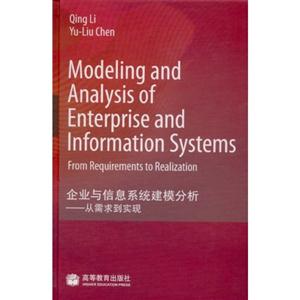企业与信息系统建模分析:从需求到实现:from requirements to realization
节选
[
《企业与信息系统建模分析:从需求到实现(精)》讲述了:Modeling and Analysis of Enterprise and Information Systems From Requirements to Realization discusses the basic principles of enterprise architecture and enterprise modeling. After an introduction to the field the General Enterprise Modeling Architecture is presented. The new architecture includes a set of models and methods. It describes different aspects of the system and covers its life cycle. Its models are structuralized models with multi-layers and multi-views. They are descriptions and cognitions of the system at the top level and provide tools and methodology to understand, design, develop and implement the system. This book is intended for researchers and graduate students in the field of industrial engineering, management engineering and information engineering. Enterprise Models discussed in this book provide a rich source in enterprise diagnosis, business process reengineering and information system implementation.
]
本书特色
[
《企业与信息系统建模分析:从需求到实现(精)》由高等教育出版社出版发行。
]
内容简介
[
本书介绍了企业及信息系统建模的主要体系框架、主要的建模体系及相关建模方法族的语法和语义,提供了在计算机辅助软件工程和信息系统设计过程中的应用案例。
]
目录
Part One Modeling Frameworks of Enterprise and Information Systems1 Introduction to Enterprise and System Modeling1.1 What Do “Analysis” and “Design” for an Enterprise Mean1.2 What is a Model1.3 Purpose and Usage of Models1.4 Content of a Model1.5 Viewpoints and Abstract Levels of a Model1.6 Modeling Methods Families1.7 Model Based System Integration and Model Driven ArchitectureReferences2 Enterprise and Information System Architectures2.1 Purposes of System Architectures2.2 Computer Integrated Manufacturing——Open System Architecture2.3 GRAI Integration Methodology and IMPACS2.4 Purdue Enterprise Reference Architecture2.5 Architecture of Integrated Information System2.6 Zachman Framework2.7 Generalized Enterprise-Reference Architecture and Methodologies2.8 Stair-Like CIM System Architecture2.9 Basic Elements Analysis of System Architectures2.10 General Enterprise Modehng ArchitectureReferences3 System Development and Integration Methodology3.1 Role of Methodology in Enterprise and System Integration3.2 StructuIed Methodology3.3 Object-Oriented Methodology3.4 GEM Structured Approach3.5 Interview Original Data Collection for a Modeling TaskReferencesPart Two Function Oriented Modeling and Analysis4 Data Flow Diagram4.1 Introduction to DFD4.2 Syntax and Semantics of DFD4.2.1 Notations of DFD4.2.2 DFD Models Organization4.2.3 Data Dictionary4.3 Structured Approach of DFD4.3.1 Modeling Process of DFD4.3.2 Data Flow Diagramming Rules4.4 DFD Modeling CaseReferences5 IDEF0 Function Modeling5.1 Introduction to IDEF05.2 Syntax and Semantics of IDEF05.2.1 Basic Concepts and Rules of IDEF05.2.2 IDEF0 Diagrams5.3 Structured Approach of IDEFO5.4 IDEF0 Modehng CaseReferencesPart Three Data Oriented Modeling and Analysis6 Entity-Relationship Diagram6.1 Introduction to Entity-Relationship Diagram6.2 Syntax and Semantics of ERD6.2.1 Entity6.2.2 Attribute6.2.3 Relationship6.3 Data Analysis and Normalization6.3.1 Ist Normal Form (INF)6.3.2 2nd Normal Form (2NF)6.3.3 3rd Normal Form (3NF)6.4 Structured Approach and Modeling Case of ERDReferences7 IDEFIX Data Modeling7.1 Introduction to IDEFIX7.2 Syntax and Semantics of IDEFIX7.2.1 Entity7.2.2 Relationship7.2.3 Attribute7.3 Structured Approach of IDEFIX7.3.1 Phase Zero: Project Initiation7.3.2 Phase One: Entity Definition7.3.3 Phase Two: Relationship Definition7.3.4 Phase Three: Key Definition7.3.5 Phase Four: Attribute DefinitionReferencesPart Four Process Oriented Modeling and Analysis8 IDEF3 Process Capture Method8.1 Introduction to IDEF38.2 Syntax and Semantics of IDEF38.2.1 Basic Concepts of IDEF38.2.2 Process Diagram8.2.3 Object Diagram8.3 Structured Approach of IDEF3References9 Other Kinds of Process Modeling Methods9.1 Event-Driven Process Chain9.2 Gantt Chart and PERT9.3 Role Activity Diagram9.4 Petri Net9.5 GRAI Method9.6 Business Process Modeling NotationReferencesPart Five Object Oriented Modeling and Analysis10 IDEF4 Object-Oriented Design Method10.1 Introduction to IDEF410.2 Syntax and Semantics of IDEF410.2.1 IDEF4 Object-Oriented Concepts10.2.2 Static Model10.2.3 Behavior Model10.2.4 Dynamic Model10.3 Structured Approach of IDEF4References11 Unified Modeling Language11.1 Introduction to UML11.2 Syntax and Semantics of UML11.2.1 Static View11.2.2 Design View11.2.3 Use Case View11.2.4 State Machine View11.2.5 Activity View11.2.6 Interaction View11.2.7 Deployment View11.2.8 Model Management View11.2.9 Profiles11.3 Structured Approach of UMLReferencesPart Six Enterprise Modeling Techniques New Development12 Ontology Capture Methods12.1 Introduction to Ontology and IDEF512.2 Syntax and Semantics of IDEF512.2.1 Basic Concepts of IDEF512.2.2 First-Order Schematic12.2.3 Second-Order Schematic12.2.4 Relation Schematic12.2.5 Object State Schematic12.3 Structured Approach of IDEF512.4 Subject-Oriented Knowledge FormalizationReferences13 Economic View and Performance Modeling13.1 Introduction to Economic View and Performance Modeling.13.2 Framework of Economic View13.3 Enterprise Information System Project Selection13.3.1 Decision Method13.3.2 Decision Modeling13.3.3 ANP Application13.3.4 Sensitivity Analysis13.4 Fuzzy Performance Modeling and Measurement13.4.1 Performance Model Structure and Multi-indicators Hierarchy13.4.2 Fuzzy Performance Modeling Framework13.4.3 Knowledge Management of Fuzzy Performance Modeling13.4.4 Fuzzy Performance Measurement13.4.5 Case StudyReferences14 Models Management, Implementation and Integration14.1 Business Process Models Management and Reuse14.1.1 Challenges in Business Process Models Management14.1.2 Business Process Models Management System14.1.3 Models Classification and Retrieval in BPMMS14.2 Evaluation Indicators System Refining14.2.1 Knowledge Reuse of Evaluation Indicators System14.2.2 Structural Similarity of Evaluation Indicators System14.2.3 Refining Mechanism of Evaluation Indicators System14.2.4 Case Study14.3 Model Based Project and Process Management Integration14.4 Modeling for Product Information Tracking and Feedback14.4.1 Modeling from the System Level14.4.2 Modeling from the Process Level14.4.3 Modeling from the Information and Data Level14.4.4 Dynamic Information Acquisition and Processing withWireless Technology14.4.5 Case Study14.5 Enterprise Modeling Based Services Development14.5.1 Service Modeling Language14.5.2 Service Modeling Process14.5.3 Case StudyReferencesIndex
封面

书名:企业与信息系统建模分析:从需求到实现:from requirements to realization
作者:李清
页数:18
定价:¥52.0
出版社:高等教育出版社
出版日期:2009-01-01
ISBN:9787040249552
PDF电子书大小:84MB 高清扫描完整版
